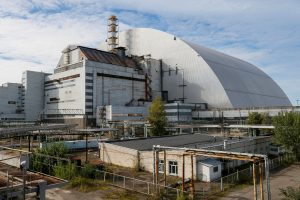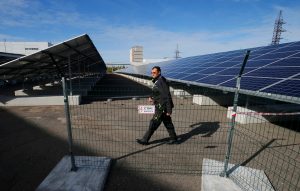
By Pavel Polityuk
CHERNOBYL, Ukraine (Reuters) – Ukraine unveiled a solar plant in Chernobyl on Friday, just across from where a power station, now encased in a giant sarcophagus, caused the world’s worst nuclear disaster three decades ago.

A new Safe Confinement arch covering the damaged fourth reactor of the Chernobyl nuclear power plant is seen near a newly built solar power plant in Chernobyl, Ukraine October 5, 2018. REUTERS/Gleb Garanich
Built in a contaminated area, which remains largely uninhabitable and where visitors are accompanied by guides carrying radiation meters, 3,800 panels produce energy to power 2,000 apartments.
In April 1986, a botched test at reactor number 4 at the Soviet plant sent clouds of nuclear material billowing across Europe and forced tens of thousands of people to evacuate.
Thirty-one plant workers and firemen died in the immediate aftermath of the accident, mostly from acute radiation sickness.
Thousands more later succumbed to radiation-related illnesses such as cancer, although the total death toll and long-term health effects remain a subject of intense debate.
“It’s not just another solar power plant,” Evhen Variagin, the chief executive of Solar Chernobyl LLC, told reporters. “It’s really hard to underestimate the symbolism of this particular project.”
The one-megawatt solar plant is a joint project by Ukrainian company Rodina and Germany’s Enerparc AG, costing around 1 million euros ($1.2 million) and benefiting from feed-in tariffs that guarantee a certain price for power.

An employee walks past solar panels at a solar power plant built on the site of the world’s worst nuclear disaster, Chernobyl, Ukraine October 5, 2015. REUTERS/Gleb Garanich
It is the first time the site has produced power since 2000, when the nuclear plant was finally shut down. Valery Seyda, head of the Chernobyl nuclear plant, said it had looked like the site would never produce energy again.
“But now we are seeing a new sprout, still small, weak, producing power on this site and this is very joyful,” he said.
Two years ago, a giant arch weighing 36,000 tonnes was pulled over the nuclear power station to create a casement to block radiation and allow the remains of the reactor to be dismantled safely.
It comes at a time of sharply increasing investment in renewables in Ukraine. Between January and September, more than 500 MW of renewable power capacity was added in the country, more than twice as much as in 2017, the government says.
Yulia Kovaliv, who heads the Office of the National Investment Council of Ukraine, said investors want to reap the benefits from a generous subsidy scheme before parliament is due to vote on scrapping it in July next year.
“Investors expect that in the renewable energy sector facilities launched before 2019 will operate on the current (beneficial) system of green tariffs,” she told Reuters on the sidelines of a conference in Odessa in September.
“And that is why investors want to buy ready-to-build projects in order to complete construction before that time.”
(Additional reporting by Natalia Zinets in Odessa; writing by Matthias Williams; Editing by Dale Hudson)


 Survivors of the massive 2011 earthquake and tsunami in Japan could be facing a serious health issue if they were near the damaged Fukushima nuclear power plant.
Survivors of the massive 2011 earthquake and tsunami in Japan could be facing a serious health issue if they were near the damaged Fukushima nuclear power plant.